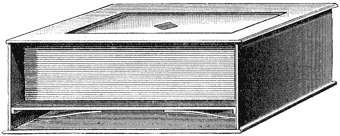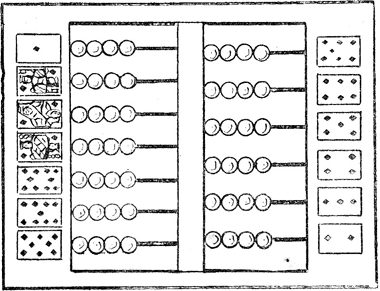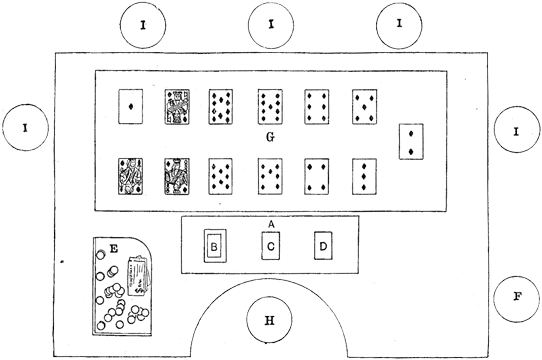
|
foreword to the online edition I. introductory II. common sharpers and their tricks III. marked cards and the manner of their employment IV. reflectors V. holdouts VI. manipulation VIII. the game of faro IX. prepared cards X. dice XI. high ball poker XII. roulette and allied games XIII. sporting houses XIV. sharps and flats
|
SHARPS AND FLATS
CHAPTER VIII THE GAME of FARO
Faro is a simple gambling card game that originated in France, in the late 17th century (should you wish to visit a site with modern card gambling games visit Spin Palace). Faro is believed to belong to the family of games that include Lansquenet and Monte Bank. It is sometimes also spelled "pharo" and in the Old West was oftentimes called "bucking the tiger." Faro used to be the most popular banking game in America throughout the 19th century. A handful of faro games even survived well into the first half of the 20th century, but then the game simply vanished from the face of the Earth, as well as from the short-term memory of the people that inhabit this planet. Note: According to BCVC.net, There were only five faro games in Nevada by the mid 1950's, and the last faro bank closed down in 1985. The problem with faro (i.e. the reason why the game vanished from the face of the Earth) lies in the fact that the game offers a very small advantage for the house. The house advantage is so small that it is virtually insignificant. This is, of course, good for the players and it is also the reason why many players can walk out with a bundle of cash -- which is definitely not what pays for the blinking lights along the Las Vegas Strip. In short, faro is not a profitable game, for the bank. Due to this fact faro banks were forced to use some "creative solutions" to boost the house edge. To make a long story short, all faro banks were crooked. Although faro is basically "dead," there are still many enthusiasts who try to keep the game alive. For further information on faro we recommend visiting Faro King, Wichita Faro and Knights of the Green Cloth. Also, rules of the game faro are explained in detail in the Rules of Card Games chapter on Playing Cards Online. FARO may almost be said to occupy in America the position of a national game. The methods of cheating used in connection with it are so numerous and so ingenious that it becomes really necessary to devote an entire chapter specially to them. Since there are parts of the world, however, outside America where the game is little known, and since it is necessary that the reader should understand something of it to enable him to follow the explanations, the first step must be to give some little idea of the nature of the game and the manner in which it is played. The following paragraphs, then, will contain a brief description of its salient features, and also of the apparatus or tools which are required in playing it. We will commence with the accessories first. These are: (1) the faro-box, (2) the check-rack, (3) the cue-keeper, (4) cue-cards, (5) the shuffling-board, (6) the layout, and (7) the faro-table. These, together with a pack of playing-cards, constitute the apparatus employed. Let us take the various items in their order as given.
1. The faro-boxThis is a metal box in which the cards are placed, face upwards, and from which they are dealt one at a time. Fig. 37 illustrates the back view of such a dealing-box. FIG. 37 It will be seen that the box is open at the back, and cut away at the top sufficiently to allow a large portion of the face of the top card to be visible. The plate forming the top overlaps the front side about one-eighth of an inch, and below its front edge is a slit, only just sufficiently wide to allow one card at a time to be pushed out, so that the cards are bound to be dealt one by one, and in the order they occupy in the pack. They are slipped out by the thumb, which presses upon them through the aperture in the top plate. The cards are inserted through the back, and constantly pressed upwards by a movable plate or partition, below which are springs sufficiently strong for the purpose. It is presumable that the object of this box is to prevent any possibility of the cards being tampered with. That it not only can be made to fail in this purpose, but also to play directly into the hands of the cheat, we shall see later on.
2. The check-rackThis is a polished wooden tray, lined with billiard-cloth. It is used by the dealer, to contain his piles of counters and his money. It stands at his left hand, upon the faro-table, during play.
3. The cue-keeper, or cue-boxThis is a piece of apparatus used for the purpose of recording the cards as they are played, and is under the control of a man who is specially told off to attend to it. By its means at any stage of the game the players can see at a glance what cards have already been played, and what remain in the pack. It is constructed upon the principle of the ancient 'abacus' or 'obolus,' and consists of a framework of wood, supporting thirteen wires, upon each of which slide four small balls (fig. 38). Opposite each wire there is attached to the framework a miniature reproduction of one of the cards of a suit. In faro, as in poker, the suit of any card is of no importance. For all practical purposes the pack may be considered as consisting simply of four aces, four kings, four queens, and so on. Therefore, no record is kept of the suits of the cards which have been played, but only of their values. The position of the balls at the commencement of the game is at the left hand side of their respective divisions, as shown in the illustration. When a king, for example, is drawn out of the box, one ball, opposite the miniature king on the cue-keeper, is slipped to the right, and so on until all the fifty-two cards have been played, when, of course, the whole of the balls are at the right of the apparatus. The person who registers the progress of the game with this accessory is styled the 'case keeper.'
FIG. 38 An original Will & Finck faro cue keeper can be seen in our extras page.
4. Cue-cardsThese are small cards upon which are printed the names of the thirteen cards, a space being left opposite each name, for the purpose of enabling the players to check off the cards as they are played. They are sometimes used in place of a case-keeper; but, even where a case-keeper is employed, they are utilized by the players for recording the winning and losing cards. Any card which wins is marked with a cross, and one which loses is marked with a nought. Fig. 39 represents a cue-card which has been partially filled up in this way, and the cards which have been played so far, it will be noticed, are readily distinguishable. The cards lost are two queens, two nines, two sevens, and three sixes. Besides showing what cards have been lost and won, the cue-card also tells what cards have yet to be played. Thus, at the stage of the game indicated in fig. 39, there are still remaining in the dealing-box one queen, one nine, three eights, two sevens, two fives, four fours, and three twos. This convenient record prevents the possibility of a player betting upon cards which have already been played.
FIG. 39 The case-keeper and cue-cards were primarily introduced with the object of keeping a check upon the dealer, and of preventing him from using a pack containing more than fifty-two cards, or in which there was not the right number of each value. We shall see presently how he manages to get over that difficulty.
5. The shuffling-boardThis is a thin slab of wood or metal, covered with billiard-cloth. It stands in front of the dealer, and upon it are placed the faro-box and the piles of winning and losing cards. It is upon this board, also, that the cards are shuffled; hence its name.
6. The layoutThe designation of this adjunct to the game is derived from the fact that it forms that part of the table upon which the players 'lay out' their stakes. Usually it is a green cloth, having painted upon it a representation of the thirteen cards of one suit (see diagram of the faro-table, fig. 40).
7. The faro-tableThis is simply an oblong table, having a recess or cavity cut out in the centre of one of the long sides. In this recess the dealer sits, being thus enabled to be as near to the layout as possible, and at the same time to have all his appliances within easy reach. Fig. 40 will give the reader a clear idea of the relative positions occupied by the dealer, the players, and the various component items of the apparatus.
FIG. 40 -- The Faro-Table A, shuffling-board. B, faro-box,
c, pile of losing cards.
|
| « collusion... (...nature of gamblers) | the game of faro (the rules) » |
home | introduction | book content | links | advertising | contact



